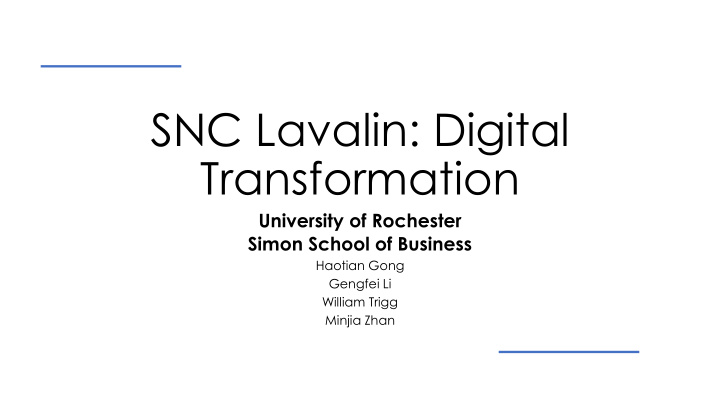



SNC Lavalin: Digital Transformation University of Rochester Simon School of Business Haotian Gong Gengfei Li William Trigg Minjia Zhan
Why Digital Transformation? - Meeting new demands from clients by digitizing our existing products and services while improving internal efficiencies by incorporating new technologies - Expand our product portfolios for potential new services for clients The Influence - New competitors that are purely technology services will take a more important role in the industry - Uncertain future in terms of demands for digital products and services
Why Digital Transformation? Funding Change in Business Model Investor’s Perspective We are pushing the Move towards a more - Equity fundraising construction industry consulting role that - Internal restructure towards a data- can supplements our - Merge oriented business products and services - Partnership model across all industries
Situation Analysis Weakness Opportunities Strength Threats Diversified Sectors High debt M&A leads to Legal risks and • • • • Strong P/E vs peers Debt ratio new business regulations • • International operations Change in • • leadership Nuclear accounting • Strong dividend monopoly in principal (IFRS vs • performance Canada Non-IFRS) Strong clientele Poor E&C • • End-to-End services performance • Profitable M&A risks(Atkins) • • Nuclear advantage • in Canada
Goals Digital transformation externally and internally Increase profits by increasing revenue externally while reducing internal costs.
Internal Analysis Goals 6 30% 25% 5 20% 4 15% 3 10% 2 5% 1 0% 0 -5% 2014 2015 2016 2017 2018 2019 2020 Adjusted diluted EPS from E&C Adjusted diluted EPS From Capital Growth rate for EPS From E&C
Internal Analysis Revenue Trend 60000 50000 40000 30000 20000 10000 0 2014 2015 2016 2017 2018 2019 2020 -10000 Revenues from E&C Growth rate Ratio of EPS Total Revenues
Internal Analysis Dividend Payout Ratio 1.400 6% 1.200 5% 1.000 4% 0.800 3% 0.600 2% 0.400 1% 0.200 0.000 0% 2014 2015 2016 2017 2018 2019 2020 Dividend per share Payout ratio Growth rate
Potential Options 1. Introduce more 3D printing, modularization and robotics technologies to reduce project risks and improve projects’ efficiency 2. Advance the AI technology to optimize the inventory and procurement process 3. Develop software that can provide performance analytics and tools that can be applied to projects
Potential Option 1: 1. Introduce more 3D printing, modularization and robotics technologies to reduce project risks and improve projects’ efficiency Benefits: Challenges: - Reduces on-site risks - Requirement for new hardware - Streamline production process and equipment - Internally training process
Potential Option 2: 2. Advance the AI technology to optimize the inventory and procurement process Benefits: Challenges: - Avoid delays caused by Just-In- - Inventory and procurement are Time inventory method estimated according to historic - Reduces labor cost and risks data, leading to higher storage associated with Just-In-Time cost
Potential Option 3: 3. Develop software that can provide performance analytics and client-facing tools to be used post-project Benefits: Challenges: - Address consumer interest in - Expensive development digital products and services process: - Expand products’ portfolio - Expand IT team - Diversify revenue stream through subscription pricing model
Solution Short-term Long-term Advance the AI Develop software that technology to optimize can provide the inventory and performance analytics procurement process and client-facing tools to be used post-project
Implementation Plan Short-term Long-term (12 – 18 months) (3 – 5 years) Utilize historic data to more Utilize our experiences and teams accurately predict inventory to develop tracking and analytics needed for similar upcoming software projects Offer as add-on service to future Expand Digital & AI Teams to apply products analytics to each sector Funded by savings from the short- Facilitated through internal term plan and post-dividend profits restructuring and post-dividend profits
Risk & Mitigation Risks Mitigation High savings and builds strong Large investment foundation for future technology Restructured format will be more Cost associated with restructuring efficient and have more accessible data
Conclusion Introducing digital transformation internally will prepare our team for the growing demand for digital services in the construction while saving money Providing these services in the long run will expand our product portfolio, keep it relevant, and improve profitability
Thank you!
Recommend
More recommend